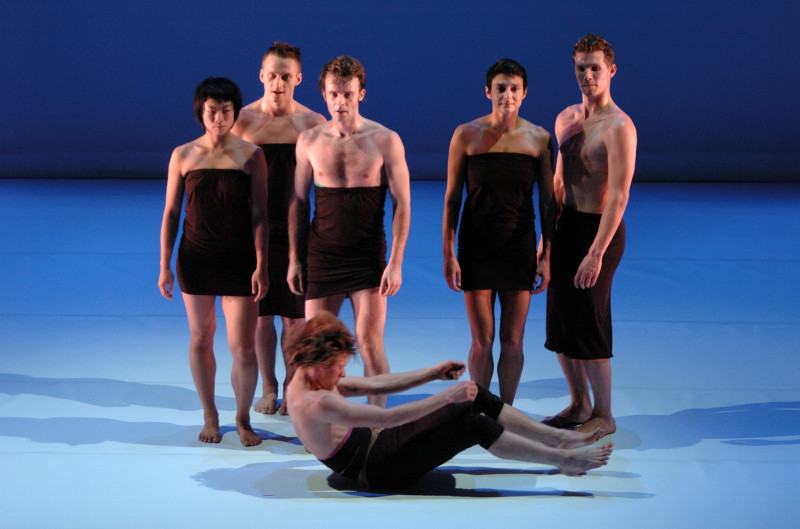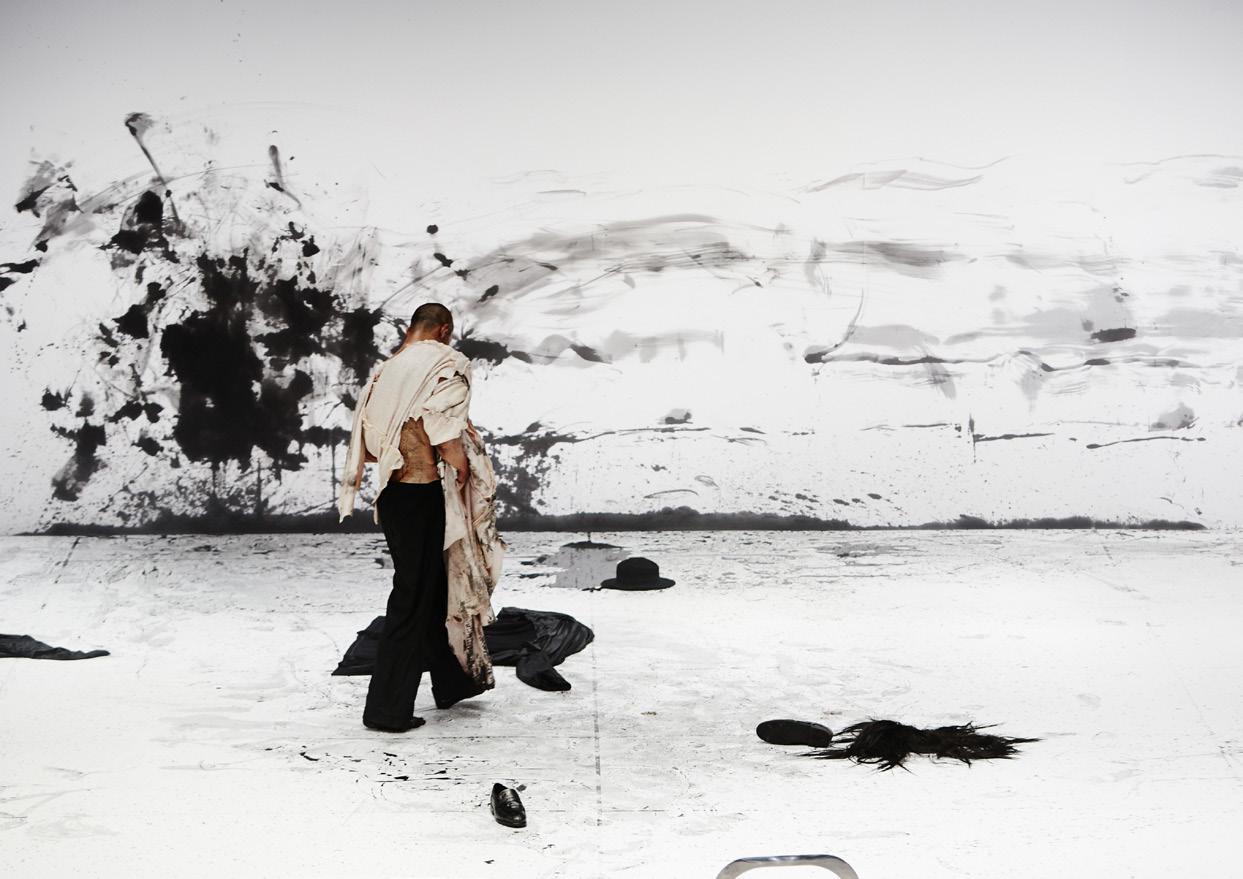Performance Info
Performance Info
About CompanyThe Ahn Eun-Me Company was formed by choreographer Ahn Eun-me in 1988 with her dance piece titled “Paper Stairs.” The company specializes in dance and choreography, but its expansive scope includes art, design, and multidisciplinary arts. The dance company has staged over 130 works and presents new works every year. In 2015 and 2016, the Ahn Eun-Me Company was invited to stage its anthropological body trilogy — which consists of “Dancing Grandmothers,” “Dancing Teenteen,” and “Dancing Middle-aged Men” — in commemoration of the Korea-France Year at the Festival d’Automne à Paris. Since then, the group has been active in Europe and Asia in partnership with France-based Gadja Productions. The company’s leader, Ahn Eun-me, is working as a resident artist at the Yeongdeungpo Art Hall in Seoul and the Théâtre de la Ville in Paris. Interviewee
Artistic Director AHN, Eun Me
Interview
Q: “Symphoca Princess Bari,” one of the Ahn Eun-Me Company’s major works, is a modern interpretation of “Bari,” a folktale based on traditional Korean folk belief. What did you want to tell via the story and how does the story unfold?
I wanted to revisit the standardized way of reinterpreting tradition and reshaping it into a new work. As you know, Shakespeare’s “Hamlet” has been reinterpreted by a myriad of writers for hundreds of years to reflect historical changes. I created “Symphoca Princess Bari” by reinterpreting the classic fairytale “Bari,” which tickles our imagination. It’s a story about Baridegi, which means an abandoned child, and is a story that can often be found in the West as well. Since only men could inherit the throne, the king waited for a son, but the queen gave birth to six princesses, and the seventh child was also a princess. So the king put the princess in a basket and floated it out to sea. A fisherman rescued the child. The child, who narrowly escaped death, found out later that she was in fact a princess and goes on a long journey in search of her parents. She meets her parents, but her father is sick and she goes to the underworld to get medical herbs for her father. She then is given the power to bring the dead back to life. I created “Symphoca Princess Bari” by compressing the magnificent narrative into two parts, “Symphoca Princess Bari-This World” and “Symphoca Princess Bari-Beyond World.” I wanted to create a collaboration between a young singer and a dancer. My strategy was to make it indistinguishable between the singers and the dancers. The singers practiced dancing so that she could sing while dancing vigorously. Dancing went well with singing. I wanted to show that the traditional sound we’re familiar with becomes a new sound when heard in a different place and time under different circumstances. Thus, this work is neither a musical nor an opera: It belongs to an unprecedented genre.
Q: The anthropological body series “Dance Tetrapartite” is a contemporary piece about Korean bodies and dance. The first work, “Dancing Grandmothers,” contains the movements of grandmothers that have been practiced for hundreds of years. How did it start? Would you briefly introduce “Dance Tetrapartite”?While I was planning a work related to regionality, I recalled the dance my mother used to dance when she felt good and asked myself why the history of Korean modern dance hadn’t been discussed by theorists. Korea lacks dance records or archiving. I was curious about how dance is embedded in the bodies of our mothers, a social minority, who were born before the modernization of Korea. So I set out on a month-long journey with a camera in a van to document the history of dance. I asked old ladies I ran across on the street to dance and took full body shots of them with the camera placed in the center. Most of their dance moves and eye expressions were identical.
When some ladies invented new moves, dancers danced together to learn them and I selected dance moves while reviewing all the shots I took. While the first part of “Dancing Grandmothers” introduced the dancers who learned the moves of the old ladies, the second part is a 17-minute-long documentary of the old ladies dancing without music, because music affects dance moves. At the end of the work, we all danced together with the ladies on the stage. This work helps me gain new insight into dance. I then staged “Dancing Teenteen and Dancing Middle-aged Men,” which portrays youths and men in their 40s to 60s, respectively, for the next three years. I also captured buildings in urban centers in “Spectacular 88 Dance,” exploring how human bodies have changed with the creation of cities. I thus completed my “Dance Tetrapartite.”
Q: Your recent work “Dragons” features millennial dancers and their elders dancing dances of various Asian cultures together. The work has been entirely revised because of the COVID-19 pandemic. Would you introduce the work in more detail?I’m affiliated with Paris’ Théâtre de la Ville. The general director said to me that the theater would feature a special program under the theme of “millennials” for five years. Since I already staged a work on that topic in Korea, I had no idea what to do. I was then invited to attend the opening of the Indonesian Dance Festival and happened to see the gala show produced by young choreographers. The dance looked like a religious ritual and was quite energetic. I was especially thrilled to see a solo work performed by a young male dancer. I felt the richness of Asian culture and began to conceive of a project involving millennial Asians. I recruited dancers from various nations in Asia — including Korea, Indonesia, Japan, Malaysia, and Thailand — but COVID-19 broke out. As they could not enter Korea, we rehearsed online. During the performance, they were shown as 3-D images using the HoloNet, as if they were dancing on the stage. I wanted to greet them in a friendly way rather than simply summoning them to the stage. I wanted to convey positive energy for the future through the performance of “Dragons” despite the COVID-19 pandemic. The whole world is learning now how to overcome the crisis. I also had a brutal time struggling with human limits to overcome them while preparing for the performance. “Dragons” was a task too challenging, yet too irresistible. At the premiere, I cried as the long period of creating and practicing dance moves together online flashed before my eyes.
Q: An aesthetician once said that “color-dance, body-improvisation, (de)joining of object and body, and modernity of random dance” are the keywords of Ahn Eun-me dance. The exhibition “Known Future Eunme Ahn,” which was held in 2019 in celebration of the 30th anniversary of your debut, explores major elements as the basis of the choreographer’s work, such as “collaboration,” “color,” “transforming,” and “dis-hierarchy.” In your opinion, what are the keywords of Ahn Eun-me’s dance? What kind of dance do you want to create? What are your goals as a choreographer?When I was young, I saw the colorful costumes worn by dancers of flower crown dance and thought that I would die if I could enter such a fantastic world. I thought I could make such a world with my dance. I inadvertently thought that there would be a beautiful and great world in a grey city, but I realized what that world meant only when I became an adult. As a woman, I belong to a minority in Korea. Society should have minority perspectives for diversity. I think I have contributed to social diversity. I’ve created the language of dance on my own while dealing with issues — such as feminism, class, instinctive colors, and desire, among others. As I’ve created works that reflected my viewpoints and insights that differed from those of others for 33 years, colorful colors come to people’s minds when they hear my name. People say that they feel happy when they see my work because I’ve emphasized colors. Making people happy and getting excited is my specialty and weapon.
Q: How do you picture the future of the Ahn Eun-me Company? What are your plans and goals for the future?Individuals should have independent thinking. We have often discussed in the past that the majority is not always right. A society is robust when diverse ideas are contested and respected. Now, technology presents videos that are optimized by algorithms on their own. We, humans, are bound to get used to convenience. We should learn new things to avoid uniformity. When experience stimulates our body, we can have new perspectives and discover new things. However, we have fewer opportunities to have that experience. That’s why we should dance to find our own bodies and language.
I myself will expand my work in that direction. I’ll make everyone in the world dance do so, too. And I think that there is a reason why we should face things that we want to hide with the help of the power of art. We should learn to see the forest for the trees in everyday life. We would like to gain new insights and wisdom to create stories from the perspectives of minorities.
Production Details
Major Productions〈Paper Stairs〉
〈Symphoca Princess Bari_This World〉
〈Symphoca Princess Bari_Beyond World〉
〈Dancing Grandmothers〉
〈Dancing Teenteen〉
〈Dancing Middle-aged Men〉
〈Dragons〉
- Associated artist of Théâtre de la Ville-Paris., France
- Artists of Gadja Productions
- 2019 Tours ‘Bienal SESC de Dança’, Brazil
- 2018 Holland Dance Festival, Netherlands
- 2017 The Place ‘Dance Umbrella’, UK
- 2015 Théâtre de la Ville-Paris, ‘Festival d’Automne a Paris’, France
- 2011 ‘Edinburgh Festival’, UK
- 2008 ‘Pina Bauch Festival(Internationales Tanzfestival NRW)’, Germany
-
Production Details
- Director
AHN, Eun Me
The New York Times compared Ahn’s work with Butoh, a form of Japanese dance theater, and an English critic lauded her as the “Pina Bausch of Asia.” Characterized by an exquisite and extraordinary language expressed through the body, a mystical color sense, dynamic energy that flows without extraneous turns, and humor, Ahn’s choreography demonstrates a dedication to move beyond the boundaries of Korean traditions and communicate with the world.
Eunme Ahn Company’s “Age Dance” was a four-year project conducted while Ahn was in residence at the Doosan Art Center. It is a three-part series, composed of “Dancing Grandmothers,” “Dancing Teen Teen,” and “Dancing Middle-aged Men,” plus a finale, “Spectacular 88 Dance.” Working with diverse themes and topics, Ahn Eunme has been expanding the realm of Korea’s contemporary dance. She has integrated “movement research” with performance. She has explored the body and movement through movement workshops to address contemporary social phenomena, and developed them into performances. She explored the body movements of grandmothers in “Dancing Grandmothers” in 2001, of teenagers in “Dancing Teen Teen” in 2012, and of middle-aged men in “Dancing Middle-aged Men” in 2014. She has made novel attempts to connect body and movement with individual and society. In the past few years, Ahn has attempted to shed new light on the social body and communicate using the abstract body, the language of dance.








 Youngmo Choe.jpg)
 Youngmo Choe(0).jpg)


 PREV
PREV
.jpeg)
.jpg)
_(c)포스(FORCE).jpg)
_(c)장석현_코끼리들이 웃는다(SUKHYUN JANG_ELEPHANTS LAUGH).jpg)
.jpg)
.jpg)
_(c)한받(Hahn Vad).jpg)
_(c)비주얼씨어터 꽃(CCOT)(1).jpg)
_(c)봉앤줄 (BONGnJOULE)(1).jpg)
_(c)대한민국연극제 2019 (Korea Theater Festival 2019)(0).jpg)
_(c)몸꼴(Momggol)(1).jpg)
2018MODAFE_Taemin Cho (2).jpg)











